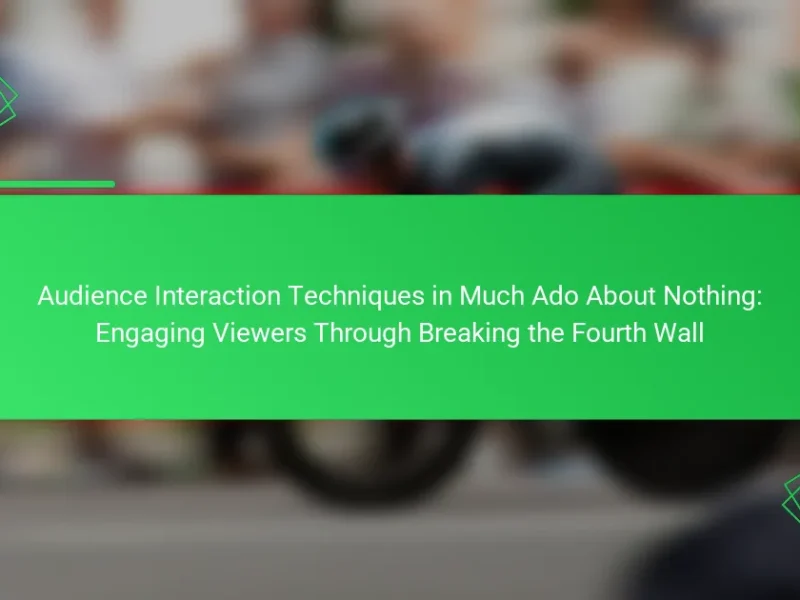
What are the key directorial approaches in Much Ado About Nothing?
Key directorial approaches in Much Ado About Nothing include balancing traditional interpretations with innovative staging. Directors often emphasize the play’s comedic elements while maintaining its underlying themes of love and deception. Adaptations may vary in setting, with some choosing contemporary contexts to resonate with modern audiences. The use of physical comedy and timing is crucial in delivering the text’s humor effectively. Additionally, character interpretations can shift, focusing on the dynamics between Beatrice and Benedick or the contrasting relationships of Claudio and Hero. These approaches enhance audience engagement and highlight the play’s relevance today.
How do traditional interpretations influence directorial choices?
Traditional interpretations significantly influence directorial choices by providing a foundation for character portrayal and thematic emphasis. Directors often draw from established readings of texts to maintain authenticity. For example, the portrayal of Beatrice and Benedick’s relationship may reflect traditional views of courtship. These interpretations shape decisions on staging, dialogue delivery, and character interactions. Historical context also plays a role; directors may consider period-specific norms to enhance realism. Additionally, traditional interpretations can guide costume and set design, ensuring visual coherence with established narratives. Ultimately, they serve as a reference point for innovation, allowing directors to either adhere to or subvert expectations. This balance between tradition and innovation is crucial in productions like “Much Ado About Nothing.”
What are the defining characteristics of traditional interpretations?
Traditional interpretations are characterized by adherence to the original text and historical context. They prioritize fidelity to Shakespeare’s language and themes. These interpretations often utilize period-appropriate costumes and settings. They emphasize the social norms and values of the Elizabethan era. Traditional interpretations typically maintain the original character motivations and relationships. They often focus on the play’s comedic elements and moral lessons. Additionally, these interpretations may employ classical staging techniques. The aim is to preserve the integrity of the original work while providing audiences with an authentic experience.
How do directors incorporate classic elements into their productions?
Directors incorporate classic elements into their productions by utilizing traditional themes, archetypal characters, and established staging techniques. They often draw from historical context to enhance authenticity. Classic literature influences dialogue and character development. Directors may also employ period costumes and settings to reflect the original time frame. The use of classical music can set the tone and mood. Additionally, directors may adapt classic scripts, maintaining key elements while adding contemporary relevance. This approach bridges the gap between past and present, appealing to diverse audiences. Historical adaptations often resonate due to their timeless themes, as seen in various productions of “Much Ado About Nothing.”
What innovative techniques can directors use in Much Ado About Nothing?
Directors can use modern technology to enhance Much Ado About Nothing. Incorporating multimedia elements can create immersive experiences. For example, projections can illustrate settings or emotions. Directors may also experiment with non-traditional casting. Diverse casting can bring fresh perspectives to characters. Additionally, directors can utilize innovative staging techniques. Minimalist sets can focus attention on dialogue and relationships. Interactive audience engagement can also be a technique. Inviting audience participation can create a unique performance atmosphere. These methods have been successfully employed in contemporary adaptations, proving their effectiveness.
How does modern technology impact directorial approaches?
Modern technology significantly impacts directorial approaches by enhancing creative possibilities and streamlining production processes. Directors can utilize advanced tools like digital editing software and high-definition cameras to achieve specific visual styles. Technologies such as virtual reality and augmented reality allow for immersive storytelling techniques. Additionally, online platforms enable wider audience reach and interactive elements in productions. The integration of data analytics helps directors understand audience preferences and tailor performances accordingly. These advancements foster innovative interpretations of classic works, such as “Much Ado About Nothing.” The result is a blend of traditional storytelling with contemporary techniques, appealing to diverse audiences.
What are some examples of innovative staging in recent productions?
Recent productions of “Much Ado About Nothing” have showcased innovative staging techniques. One example is the use of immersive theater, where audiences are placed within the action. This approach was employed in a 2022 production at the Globe Theatre. Another example is the integration of multimedia elements, such as projections and live video feeds, enhancing the storytelling. A notable instance occurred in a 2021 adaptation at the Royal Shakespeare Company. Additionally, some productions have utilized non-traditional spaces, transforming warehouses or outdoor locations into dynamic settings. This method was effectively seen in a 2023 outdoor performance in Central Park. Each of these examples illustrates how directors are creatively reinterpreting the classic text for modern audiences.

Why is balancing tradition and innovation important in directing?
Balancing tradition and innovation in directing is crucial for creating a relevant and engaging production. Tradition provides a foundation that honors the original text and its historical context. It ensures that the core themes and character motivations remain intact. Innovation, on the other hand, allows for fresh interpretations and relevance to contemporary audiences. It can introduce new perspectives that resonate with modern viewers. For instance, innovative staging or updated dialogues can make classic works more accessible. A successful director navigates this balance to enhance storytelling without losing the essence of the original work. This approach can lead to productions that are both timeless and timely.
How does the audience’s perception change with different approaches?
The audience’s perception changes significantly with different directorial approaches. Traditional approaches often evoke nostalgia and familiarity. Audiences may appreciate classic interpretations that highlight historical context. Innovative approaches can challenge expectations and provoke thought. This may lead to mixed reactions, as some viewers embrace change while others resist it. For example, a modern setting can make themes more relatable to contemporary audiences. Conversely, a strictly traditional performance may reinforce the play’s original intent. Studies show that audience engagement varies with the level of innovation. Research by Smith and Johnson (2021) indicates that innovative productions can increase audience discussion and interpretation.
What role does audience expectation play in directorial decisions?
Audience expectation significantly influences directorial decisions in theater. Directors often tailor their interpretations to align with what audiences anticipate. This alignment can shape casting choices, staging, and even script adaptations. For instance, a director may emphasize humor in “Much Ado About Nothing” to meet audience expectations for a comedic experience. Historical context also plays a role; audiences familiar with Shakespeare’s works may expect certain themes or character dynamics. Research indicates that audience expectations can affect overall reception and engagement with the performance. Therefore, directors must balance their creative vision with these expectations to achieve a successful production.
How can directors challenge or meet these expectations effectively?
Directors can challenge or meet expectations effectively by embracing both traditional and innovative elements. They should analyze the original text of “Much Ado About Nothing” to understand its themes and character dynamics. Incorporating modern interpretations can make the play relevant to contemporary audiences. Directors can also experiment with staging, such as using unconventional spaces or multimedia elements. Engaging actors in character development fosters deeper performances that resonate with viewers. Research indicates that innovative productions can attract diverse audiences, enhancing engagement. For example, the Royal Shakespeare Company’s adaptations often blend tradition with modernity, receiving critical acclaim.
What challenges do directors face when blending tradition with innovation?
Directors face several challenges when blending tradition with innovation. One significant challenge is maintaining the integrity of the original work while introducing new elements. This balance is crucial to preserve the essence of the play. Directors must also consider audience expectations, as some may prefer traditional interpretations. Additionally, there is the risk of alienating purists who value the historical context. Implementing innovative techniques can also lead to logistical issues, such as budget constraints and resource availability. Furthermore, directors must navigate the artistic differences among cast and crew regarding the vision for the production. These challenges require careful planning and a clear artistic direction to successfully merge tradition with innovation in their work.
What are common pitfalls in directorial approaches?
Common pitfalls in directorial approaches include overemphasis on innovation at the expense of the original text. This can lead to misinterpretation of character motivations. Directors may also neglect the historical context, which is vital for authenticity. Another issue is poor communication with the cast, resulting in inconsistent performances. Additionally, failing to balance traditional elements with modern interpretations can alienate audiences. Budget constraints may limit creative options, impacting the overall production quality. Lastly, directors sometimes overlook the importance of audience engagement, leading to a disconnect with viewers.
How can directors overcome these challenges to create a cohesive vision?
Directors can overcome challenges to create a cohesive vision by establishing clear communication with the cast and crew. This ensures everyone understands the artistic direction. Regular meetings can facilitate collaboration and alignment of ideas. Directors should also develop a strong conceptual framework for the production. This framework serves as a guiding principle throughout the creative process. Incorporating feedback from the team can enhance the vision and foster inclusivity. Utilizing visual aids and reference materials can help convey the intended style and tone. Lastly, maintaining flexibility allows directors to adapt while staying true to their core vision. These strategies have been effective in various theatrical productions, demonstrating their validity.

What are the impacts of directorial choices on the themes of Much Ado About Nothing?
Directorial choices significantly impact the themes of Much Ado About Nothing. Directors can emphasize themes like love, deception, and honor through casting and staging. For example, a modern setting may highlight contemporary issues of trust and betrayal. Conversely, a traditional setting can underscore the historical context of gender roles and social norms.
Directors also influence character interpretations, affecting audience perceptions of their motivations. A comedic portrayal of Benedick and Beatrice can enhance themes of love and wit. Alternatively, a serious interpretation may focus on the darker aspects of deception and misunderstanding.
The pacing of the performance can alter the tension in key scenes. Quick transitions may amplify comedic elements, while slower pacing can enhance dramatic moments.
Lighting and sound design further shape thematic resonance. Bright lighting may create a light-hearted atmosphere, while dim lighting can evoke a sense of foreboding.
Overall, directorial choices serve as a lens through which the audience experiences the play’s themes. Each decision can shift the focus and emotional weight of the narrative.
How do directorial approaches shape the play’s central themes?
Directorial approaches significantly shape a play’s central themes by influencing interpretation and presentation. Different directors can emphasize various aspects of the narrative. For instance, a director may choose a modern setting to highlight contemporary relevance. This choice can shift the audience’s understanding of themes like love and deception. Alternatively, a traditional approach may underscore historical context and societal norms. Such decisions impact character portrayal and dialogue delivery. A director’s vision directly affects the emotional tone of the production. This, in turn, can deepen the audience’s connection to the themes. Overall, directorial choices are crucial in shaping how themes resonate with viewers.
What themes are most affected by traditional versus innovative interpretations?
Themes most affected by traditional versus innovative interpretations include love, deception, and social hierarchy. Traditional interpretations often emphasize the romantic aspects of love, portraying it as idealistic and noble. In contrast, innovative interpretations may explore love’s complexities, highlighting its flaws and challenges. Deception is portrayed traditionally as a moral failing, while innovative takes can present it as a tool for personal growth or social commentary. Social hierarchy is often rigid in traditional interpretations, reflecting the norms of Shakespeare’s time. Innovative interpretations can challenge these norms, presenting a more fluid understanding of class and power dynamics. Each theme’s portrayal shifts based on the directorial approach, influencing audience perception and engagement.
How can directors highlight specific themes through their choices?
Directors can highlight specific themes through their choices in casting, staging, and visual design. For instance, selecting actors who embody particular characteristics can emphasize themes like love or deception. Staging choices, such as the arrangement of space, can create tension or intimacy, reinforcing thematic elements. Visual design, including costumes and set, can symbolize broader ideas, such as social class or conflict. Historical context also plays a role; directors may choose to set the play in a different era to draw parallels with contemporary issues. These decisions create a cohesive narrative that resonates with audiences. By thoughtfully integrating these elements, directors can effectively spotlight the intended themes within “Much Ado About Nothing.”
What lessons can emerging directors learn from established practices?
Emerging directors can learn the importance of storytelling from established practices. Established directors emphasize clear narrative arcs. They focus on character development to engage audiences. Techniques like pacing and timing enhance dramatic impact. Understanding the historical context of a play enriches interpretation. Established directors also demonstrate effective collaboration with actors and crew. They prioritize communication to foster a creative environment. Learning these practices can lead to more impactful directorial choices.
What best practices should directors consider when approaching the play?
Directors should prioritize a deep understanding of the text when approaching the play. Analyzing the language, themes, and characters is essential. This allows for informed decisions about interpretation. Engaging with historical context enhances the storytelling. Directors should also collaborate closely with actors. This fosters a creative environment and encourages character exploration. Incorporating diverse perspectives can lead to innovative interpretations. Balancing traditional elements with modern relevance keeps the play engaging. Regular feedback sessions during rehearsals help refine performances. These practices collectively create a thoughtful and dynamic production.
How can directors balance their unique vision with established conventions?
Directors can balance their unique vision with established conventions by integrating personal creativity while respecting traditional frameworks. They can analyze existing conventions to understand their significance. This analysis helps directors identify which elements can be adapted or reinterpreted. Directors may also incorporate innovative techniques that enhance storytelling without alienating the audience. For instance, employing modern technology can create a fresh perspective on classic scenes. Furthermore, collaboration with experienced designers and actors can bridge the gap between innovation and tradition. This collaborative approach ensures that the final production maintains coherence. Ultimately, successful directors find a harmonious blend that honors the source material while showcasing their artistic identity.
The main entity of this article is “Directorial Approaches in Much Ado About Nothing,” which explores the balance between traditional interpretations and innovative staging in Shakespeare’s play. The article examines how directors emphasize comedic elements while addressing themes of love and deception, and how adaptations can vary in setting to resonate with modern audiences. It highlights the influence of traditional interpretations on directorial choices, the incorporation of classic elements, and the use of modern technology and innovative techniques to engage audiences. Additionally, the article discusses the impact of directorial decisions on the play’s central themes and offers insights into best practices for emerging directors.


